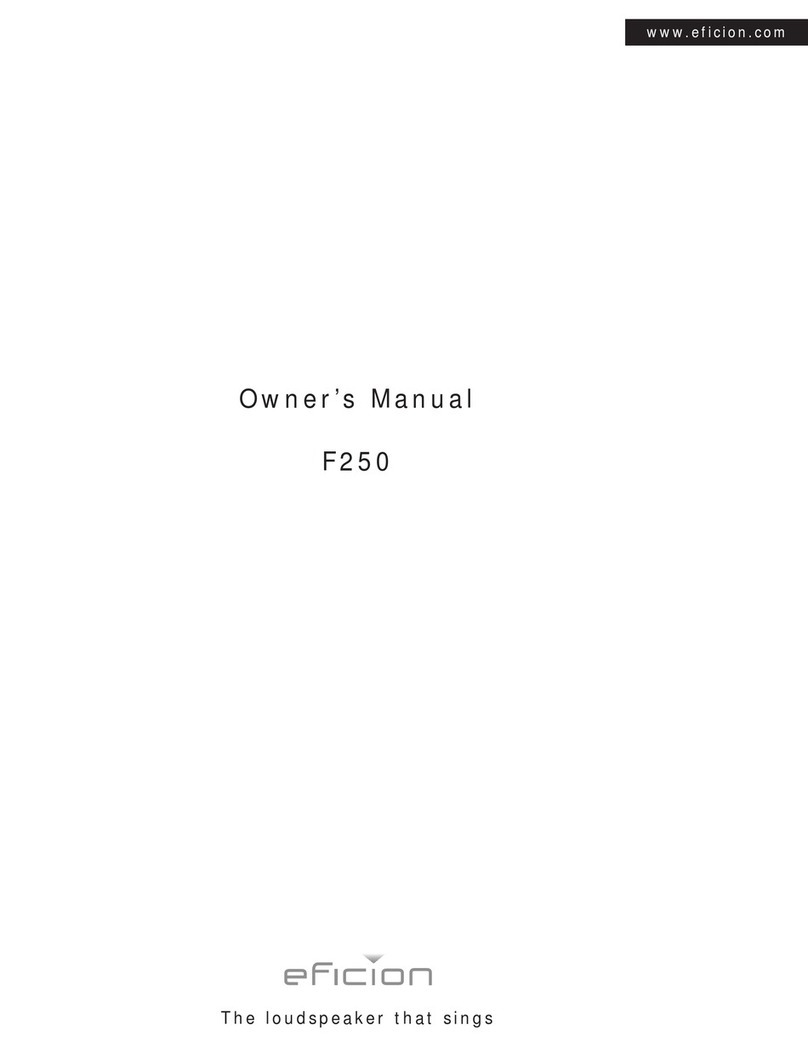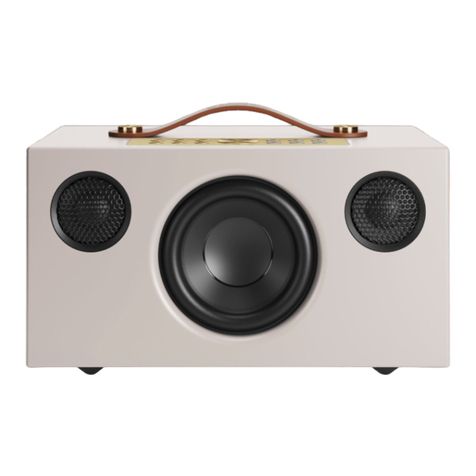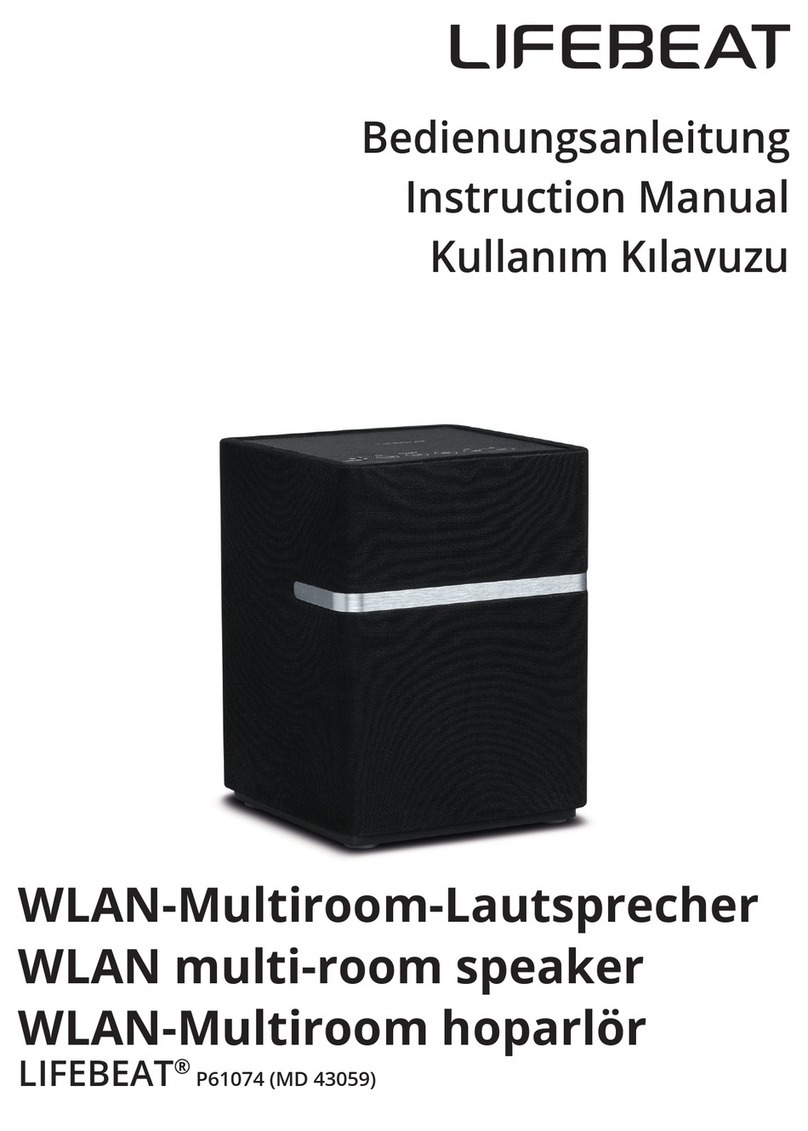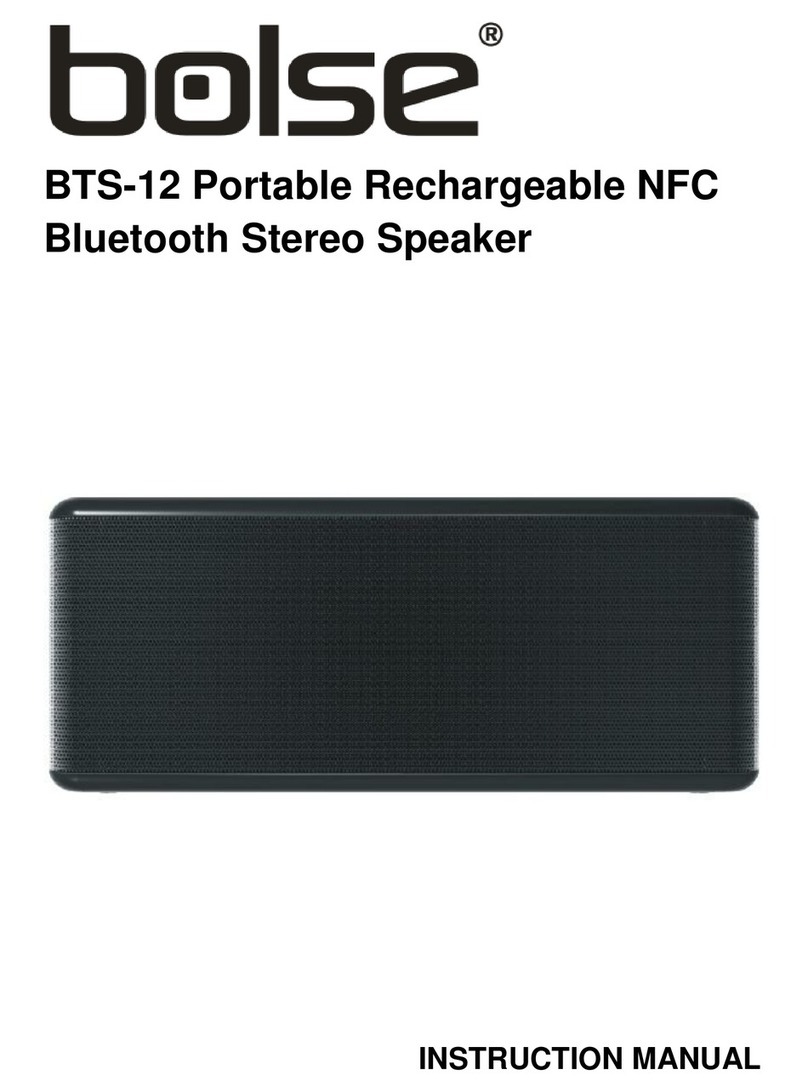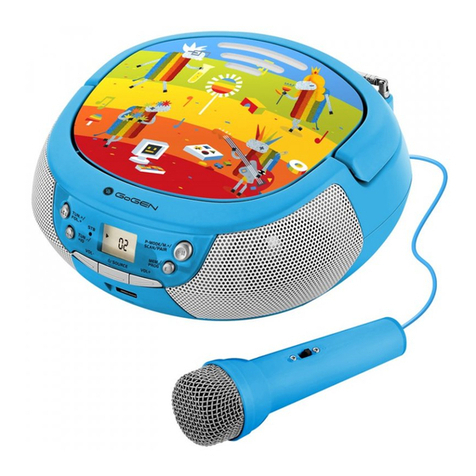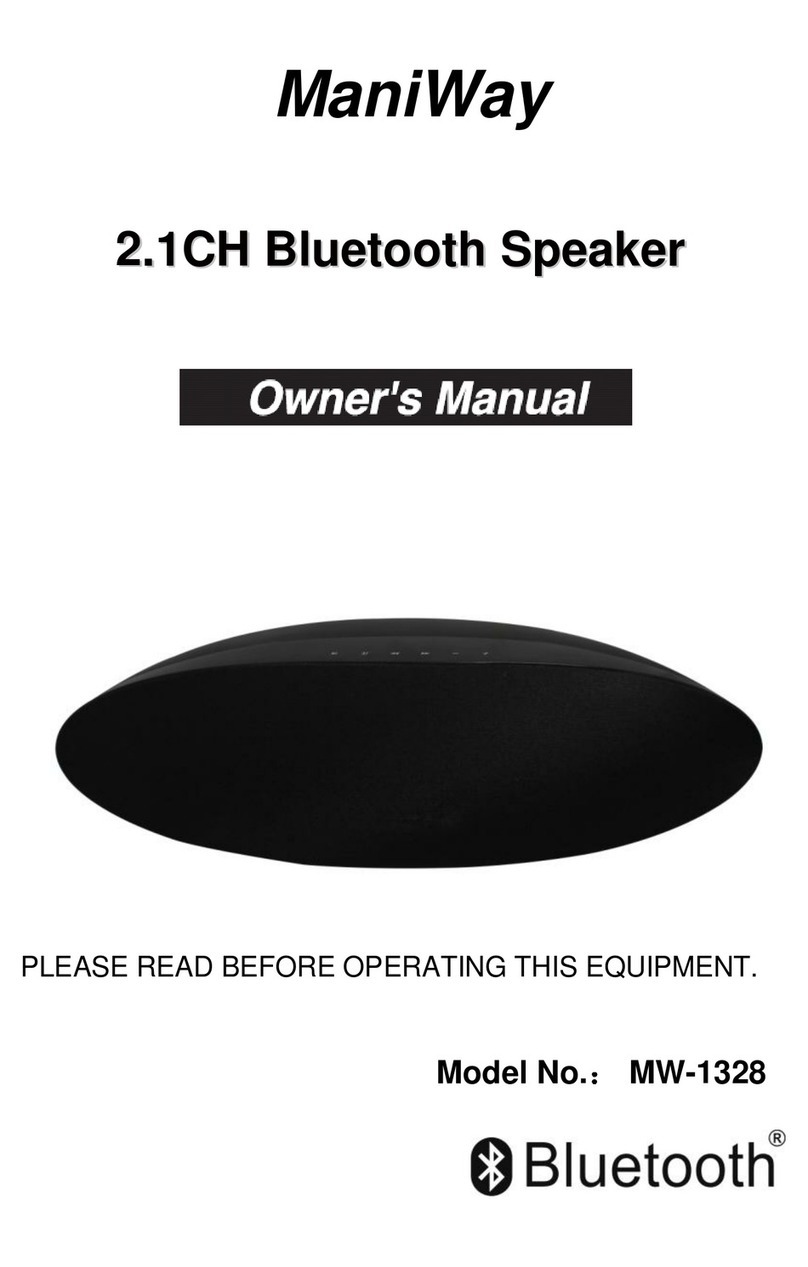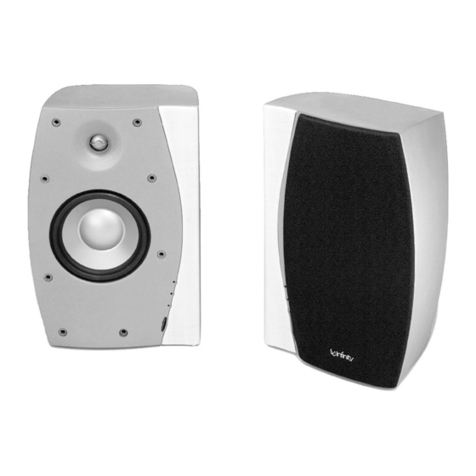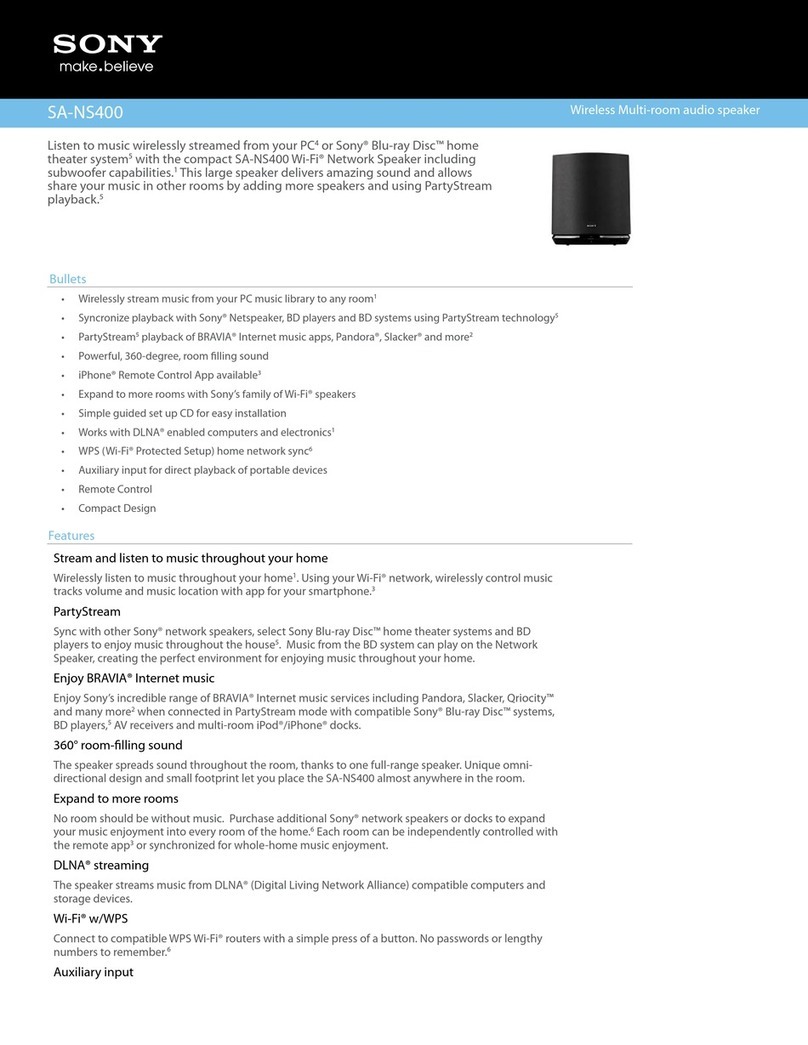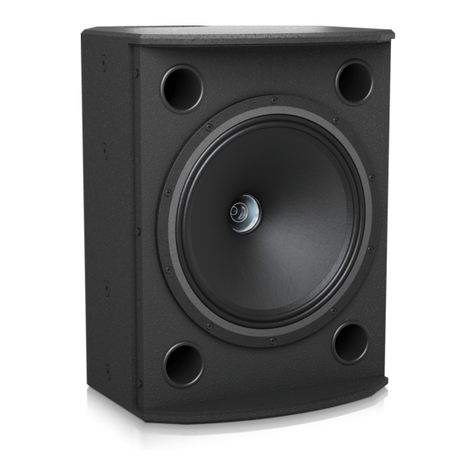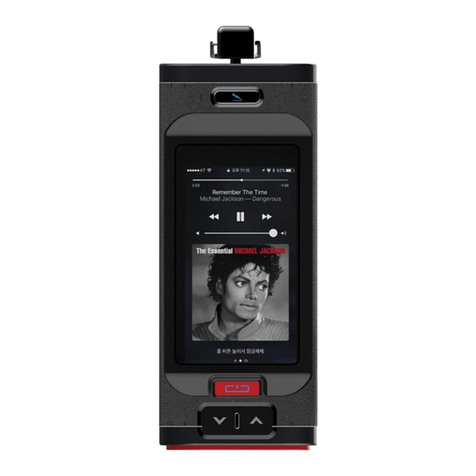Eficion F300 User manual

www.eficion.com
The loudspeaker that sings
Owner’s Manual
F300

www.eficion.com
Dear Customer,
We would like to thank you for choosing a pair of our speakers
and congratulate you on your choice. This manual is to provide you
information for properly setting up the speakers and to optimize the per-
formance.
Safety Precautions
Do not place any magnetic sensitive electronic devices, such as mag-
netic data storage systems and computers, within approximately two
feet of the speaker.
Please refer to Fig. 2A or 2B for proper speaker cable connections.
1

www.eficion.com
2
Open the top Flip over Pull up
(a)
(b)
Open the top &
Take out the top foam
Lay on the side (side of the speaker)
Pull out the speaker by holding onto
the terminals and the grille
Fig. 1 unpacking
Note: accessaries such as spikes are contained in the
concave spaces of the bottom packaging foam.

www.eficion.com
3
+ AMPAMP -
F300M
F300S
Fig. 2A single-wiring model connections
-+
-+

www.eficion.com
4
+ AMPAMP -
F300M
F300S
(a) Bi-wiring connections
+ AMPAMP -
F300M
F300S
(b) Single-wiring connections
Fig. 2B bi-wiring model connections
-+
-+
-+
-+

www.eficion.com
Unpacking and Handling
The F300, especially the bass unit (F300S), is both heavy and relatively
delicate and must be handled with care. When moving the speaker still
in the cardboard box, gentle rolling is generally allowed. But dropping
from any height should absolutely be avoided. It is preferable to unpack
the speakers close to the position at which they are to be used.
Fig. 1 illustrates two alternative ways to take the speaker out of the box.
After taking out the speaker, please also take out the foam at the bottom
as accessories are placed in the concave spaces of the foam.
Speaker Placement
The speakers should be placed 7 to 9 feet apart (measured between
nearest sides) for a natural sound stage. Too far apart, while focus still
maintains, the sound stage may become artificially wide. An ideal
listener to speaker distance should be that the two speakers and the
listener are at three corners of an equilateral triangle. Ideally, the speak-
ers should be at least 2 feet away from the back and side walls. Moving
the speakers further from the walls will generally reduce the volume of
bass. Space behind the speakers will also help to expend depth of the
sound stage. Because of the uniform sound dispersion of an air motion
transformer (AMT) tweeter employed by the F300, distance to the side
wall is not as critical as that of dome tweeter speakers. For the same
reason, toe-in (speakers pointing at the listener) is generally not
needed, in fact, not preferred as less toe-in may fill the room better.
Most room treatment experiences are developed based on the widely
used dome tweeter which beams sound and tends to have problems
with rooms. Because the F300’s AMT tweeter, which is a dramatic depar-
ture from traditional dome tweeters, has a wide and uniform horizontal
dispersion pattern, the F300 is less affected by the room, and placement
is relatively more forgiving. However, since the F300 produces substan-
tial amount of bass, bass traps, especially at the corners, can often
5

www.eficion.com
make quite a difference. Hanging heavy fabrics at the corners can be a
simple yet elegant solution.
Bulky objects, such as a tall equipment rack or a rear-projection TV set,
placed directly between two speakers have negative effect on the sound
stage. They should either be moved as far back as possible or be cov-
ered with a sound absorbing material, such as a heavy curtain.
Speaker Installation
It is important to ensure that the speakers stand firmly on the floor
using the height adjustable spike feet supplied whenever possible. The
spike feet are designed to press the carpet to the floor surface. For hard
surface floor, place a puck supplied underneath each spike foot.
Place four isolation pucks on top of each bottom unit (F300S), and then
rest the top unit (F300M) on the isolation pucks.
Tapes covering the tweeters (front and back) need to be removed before
powering up the speakers. First you need to gently pull off the grilles,
then you will see the tapes.
Figs. 2A and 2B illustrate cable connections to the speakers. In the
single-wiring model shown in Fig. 2A, the crossover circuit is in the bass
unit (F300S). Amplifier is connected to the “IN” terminals of the bass
unit. Using the provided cables to connect the bass unit’s “OUT” to the
top unit’s “IN”. In the bi-wiring model shown in Fig. 2B, both the top unit
(F300M) and the bass unit (F300S) have crossover circuit. The speaker
can either be connected as bi-wired or single-wired. Please follow the
Fig. 2B for appropriate connections. For bi-wiring model, using bi-wiring
connection is preferred especially when the amplifier has ample power.
Keep cable as short as possible may be more beneficial than an expen-
sive but long cable, as inductance, which affects high frequency
response, is proportional to the cable length. See inductance equation
6

www.eficion.com
in straight wire conductor:
, where L = inductance (nH), l = length of
conductor (in), and d = diameter of conductor (in). Apparently increas-
ing diameter is far less effective in reducing the inductance than reduc-
ing length of the wire.
Break-in Period
The performance of the speaker will change subtly during the initial
listening, as the suspension materials of the drivers need time to loosen
up. Generally 8 hours of break-in will get you most of the performance.
However, as many as 80 hours may be needed to fully break in the
woofer.
To some people, the break-in process is also a psychological one, as our
brain needs to re-tune to a new kind of sound. Fully appreciating the
F300 may not happen until after about a week of listening to it.
Aftercare
The cabinet surfaces usually only require dusting. Soft cloth damped
with warm water may be enough to remove grease. If you wish to use
chemical agents, chose with caution and always test first on a small area
on the back of the speaker. Avoid products that are abrasive, or contain
acid, alkali or anti-bacterial agents. Do not use cleaning agents on
diaphragms of the drivers. Do not cause strong air flow to or from the
tweeter diaphragms.
7
)1
4
(ln08.5 −⋅⋅= dl
lL

www.eficion.com
Specification
Design: 3-way 4-driver vented box.
Frequency response: 25 Hz - 40 kHz.
Sensitivity: 89 dB/2.83V/1m.
Impedance: 8 ohms (minimum 6.4 ohms).
Tweeter: air motion transformer, diaphragm area: 5-1/8" x 1-3/16".
Super tweeter: Aluminum ribbon with honeycomb structure, rear-
firing, diaphragm area: 2-1/3" x 1/3".
Midrange: 6.5", non-woven carbon fiber sandwich cone.
Woofer: 12", non-woven carbon fiber sandwich cone.
Crossover: 1300 Hz and 110 Hz.
Dimensions (HWD): 42.5″×15.6″×17″.
Weight (net): 158 lb/side.
8
Table of contents
Other Eficion Speakers manuals
